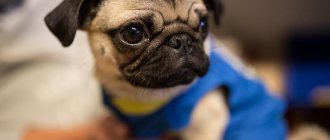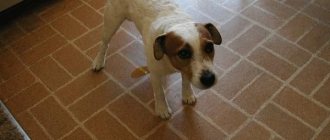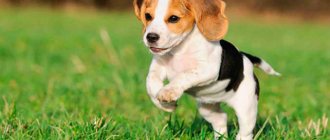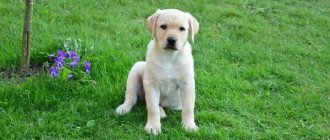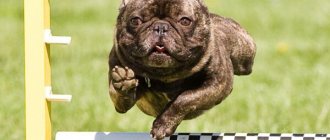So, your puppy has already had two vaccinations and after the second one 10 days of quarantine have passed. Congratulations, you can go for a walk!
The first walks should be short - they are needed not for physical activity, but for social adaptation. It is better not to communicate with dogs for now. Your goal is to teach the puppy to leave the entrance on a leash and follow you. It’s best to go on your first walk together. The first to go is the one with whom the puppy spends more time, whom he loves more - the puppy will follow the leader more willingly. The second person holds the puppy on a leash and walks behind him, nudging him under the butt with his foot if necessary. If the puppy is afraid to go into the elevator or leave the entrance, the leader calls and encourages, and the second one pushes. All this must be done quickly enough - do not leave the puppy time to think. When you go outside, give him food (a cracker), praise him and leave him alone, let the puppy sniff and go wherever he is interested. As soon as you see that he has become comfortable, you can return home (for the first time, you can carry the puppy back in your arms). Walking time is 10-15 minutes. It’s better to walk often, but little by little! Don't let your puppy get tired, including emotionally.
If it happens that the puppy does his toilet chores on the street, praise him exaggeratedly so that he remembers. If you want to achieve this faster, go for a walk immediately after sleep and after each meal.
Small Labrador puppies are not allowed to walk on stairs. Of course, a few steps from the elevator are not too much of a burden, but it is better to overcome them, keeping the puppy on a short leash, taking your time and preventing him from jumping. If you have a fifth floor without an elevator, you will have to carry the puppy in your arms. How long? As long as you are able to lift it. From about 4 months, start teaching your puppy to walk up stairs, do it gradually. Then down. When going down the stairs there is a lot of stress on the joints.
Is it suitable for living in an apartment?
Active dogs, which include the Labrador, need adequate physical activity . First of all, the state of health, both psychological and physical, depends on this.
Any breed of dog can be kept at home if it is given proper attention. Frequent long walks, active outdoor games and training.
If the Labrador is not stressed, then in the first years of its life it will dump excess energy into destroying its home . How could it be otherwise if he is locked within four walls?
Over time, the dog imitates the lifestyle of its owners. Lazy people are not recommended to own Labradors. Without activity, dogs quickly gain weight due to metabolic disorders .
They become as lethargic as their owners, which is contrary to the nature of this breed.
Advantages and disadvantages
Before you start keeping a Labrador in an apartment, you should note several disadvantages of this decision.:
- the need to provide daily active load;
- the dog is recognized as a source of infections;
- the presence of long hair - during seasonal molting, the hair needs to be combed every day, intensive cleaning of the room and cleaning of furniture will be required;
- the need to devote a lot of time to the education process.
But all these disadvantages are fully compensated by certain advantages.:
- the appearance of a faithful friend;
- the labrador will happily go for a run with its owner in the morning;
- gets along well with children and can become a nanny;
- will not offend family members;
- With proper training, it performs security functions, although it is considered a completely non-aggressive dog.
Collar and leash
Uniforms are necessary so that you can control the animal’s movements and keep the dog with you. For the first walks, this is extremely important and it is not recommended to let him off the leash at all. Otherwise, you will have to make more than one circle around the park in search of the fugitive. And we shouldn’t forget about the danger. Strange dogs, stray dogs, roads and transport, and, in the end, people who, at times, can commit inappropriate acts when they see an animal rushing at them.
Therefore, remember rule N1. The first three walks are introductory, we do not let the animal off the leash under any pretext. You can give your dog freedom by letting him go longer distances, but you should always have the leash in your hands.
How to choose a collar for a Labrador
If you have a Labrador puppy, a collar is one of the first things you should buy. Give preference to quality materials and adjustable designs. In this case, the product will last a long time and will not need to be changed as the animal grows.
For very young people, a harness is good . Labrador will be completely under your control. In addition, the puppy will not be able to harm itself in the event of sudden movements or jerks, as often happens with conventional collars. Also, harnesses are good for those who have not been able to wean their Labrador from pulling on the leash while walking . Although, this bad habit must be fought until it is completely eradicated.
The size of the collar for a Labrador should be no more than four centimeters wide. As for volume, this is an individual matter. Remember, it should not put pressure or cause discomfort to the animal. But, at the same time, the dog should not slip out of it. Ideally, a finger should fit comfortably between the neck and collar.
A Labrador does not need a strict collar in everyday life. But if you decide to seriously engage in the behavior and education of an animal, you cannot do without it. But, nevertheless, we do not recommend using it yourself. It’s better to arm yourself with the help of professional dog handlers and look at the area where other dogs are training.
How to choose a leash for a Labrador puppy
It would seem that there is nothing complicated here. Take the one you like and go for a walk. But, not everything is so simple. When choosing, you should take into account the physiological characteristics of the animal. In particular, his weight, age and activity.
For Labrador puppies, the leash should not be too long. Since this will make it difficult to control the animal’s actions. And besides, kids are too inquisitive and want to try everything by their teeth.
The best leash for a Labrador older than six months is one that is durable and allows for different lengths. Ideally, it will be made of durable and heavy-duty materials such as nylon or tarpaulin.
Important! Don't forget that a leash is a guarantee of your animal's safety, and not just a fashion accessory. Choose wisely, looking at practicality rather than just looks.
Is it suitable for outdoor use?
Dog experts have different opinions about keeping a Labrador outdoors. This breed was bred as a hunting companion. Keeping it on the street should not mean that the dog is left to its own devices and is on an independent walk.
Loneliness has a negative impact on the animal’s psyche, so to keep a dog on the street, you must not deprive the dog of communication with family members.
Only joint walks and games compensate for the lack of attention.
Labradors can tolerate low temperatures. But for central Russia, for a dog to live on the street, it is necessary to take care of insulating the enclosure in winter.
The animal should have enough space to stretch out its paws and walk around . Always ensure there is clean water in the bowl.
An insulated enclosure, with lighting, and a large area is an acceptable option for keeping a Labrador outdoors.
Advantages and disadvantages
An aviary is the only option for keeping a Labrador outdoors.
The booth is not suitable for several reasons:
- A dog on a chain psychologically feels responsible for what is happening; it’s the same as a leash. She cannot relax and is always tense. The enclosure is like a cage, with a secluded place for the dog to rest and a small area for eating, with minimal space for activity.
- In an enclosure, the dog is better protected from precipitation: snow, rain. The wooden podium protects from dirt.
Among the advantages is that the dog is always in the fresh air . Seasonal temperature changes affect the formation of the coat gradually, which is completely different from apartment housing, centralized heating in the winter months.
This does not mean that a dog living on the street does not need to be brushed. This needs to be done less often.
A Labrador living outdoors needs more careful inspection . Enhanced protection against ticks and fleas. It is necessary to ensure that there are no other sick animals in the area.
Basic rules of care
Training is the basis of mutual understanding between owner and dog . It also gives the pet an intellectual challenge. To live together with a dog in an apartment, it is important to develop self-control and develop stable behavior.
Loud barking, loud whining and running around will cause a lot of trouble for the neighbors.
You need to teach the puppy to calm down and strictly follow commands. Then there will be no problems with an adult Labrador in the apartment, even if he meets a cat at the entrance.
Active games and sports training are the key to ensuring that the dog gets the necessary physical activity . This is very important for apartment pets.
Being alone, they experience stress and try everything. So, the dog struggles with emotions. A tired dog goes to bed after a walk.
Curious puppies often chew on shoes and other accessible objects due to teething . You can ensure their safety by putting things away in advance.
All wires and cords must be kept out of reach. Small, fragile objects at an unattainable height.
Expert opinion
Kozhevin Semyon Kirillovich
Expert dog handler.
Labradors can be kept in an apartment provided that early training begins. First of all, the pet is taught to go to the toilet, to a specially designated place and not to bark loudly. If during training the animal does not succeed in everything right away, then under no circumstances should you raise your voice at him, as this can harm his psychological state. Daily walks are required; if the pet is taken for a walk, it will not cause any problems in the apartment.
First days at home - what should you do?
Before the puppy appears in a private home, you need to purchase a number of necessary things:
- toys;
- feed;
- bowls for food and water;
- dog bed or mat;
- brush.
Puppies don't know how to endure . Therefore, it will not be possible to avoid puddles, but the animal can be trained to go in a diaper or in a litter tray - you need to take care of the place in advance.
Where is the dog's private place?
Dogs have distracted attention. This does not mean that they cannot concentrate and are easily distracted.
This indicates that the dog is always busy with something..
Either he sniffs something, or he watches the behavior of the owner. The next minute he’s already chasing his tail. At the same time, he can quickly take off from his place for his favorite toy if he calls out to it.
The owner and his family are the most important people for a pet. The animal will not leave them without attention, no matter what they do. Happy to join you for lunch and take part in the game.
Labradors are people-oriented by nature . They will keep company while watching TV, sitting closer to their person. They will obediently wait for the time to walk.
Given these points, the dog should have its own place in the house so that it can relax and not be distracted . A secluded corner is chosen for the pet, even before the puppy arrives in the home.
Positive associations are formed through encouragement.
CAREFULLY!
You should never scold a dog when it is in its place. Children and other family members should not be allowed to handle the puppy.
“Place” will become an effective command so that the dog does not interfere when other people come to visit and does not get in the way.
Video about Labradors
Below is a funny video about Labradors, where you can appreciate the friendliness and loyalty of this breed:
Buying a Labrador is a big step because you will have to devote as much time to the dog as you would to your own child. Of course, it will be difficult at first, but it will be much easier for you when you get used to all the difficulties like getting up in the morning for a walk. A dog is a man’s best friend, and you will never find a more loyal one, so never give up on the idea of purchasing one, especially if you have the means and time to afford it.
How to feed?
It is difficult to answer unequivocally what diet to choose for a dog without consulting a veterinarian and assessing the state of health.
The markets offer a huge range of dry food and wet canned food for large breeds of dogs. You can feed your Labrador with natural food by first creating a balanced menu .
Dry food is easy to use. It is enough to calculate the required daily intake based on the age and weight of the animal. You should always make sure your dog has clean water in his cup. Sometimes the diet can be varied with wet food.
Natural nutrition is difficult in that it is necessary to include in the diet daily:
- meat;
- cereals;
- vegetables.
If your pet develops an allergy, it will take a long time to find out which product. Excluding one by one, then the other. It is necessary to regularly give your dog vitamins.
You need to be careful with dairy products, they can cause diarrhea.
For the first few weeks, puppies should be fed the same food they received from the breeder. If this is not dry food, then you should provide a similar menu as much as possible.
Mixing homemade food and dry food is harmful . They have different contents of useful elements and proteins, which disrupts metabolism.
Feeding your dog chips, sweets and any food from the table is prohibited. Sugar is bad for all dogs. Fried foods cause cardiovascular disorders. Fatty – disrupts the functioning of the gastrointestinal tract.
Labradors do not need a varied menu . The main thing is that they receive a sufficient amount of vitamins, proteins and carbohydrates from food. Sometimes you can treat your dog to a beef bone or carrot.
Dogs are not allowed:
- onion;
- mushrooms;
- nuts;
- chicken and fish bones;
- citrus;
- berries.
Puppy diet
Caring for a Labrador requires proper organization of feeding from childhood. Puppies are given ready-made industrial food aimed at this age group (Akana, Brit Care brands). From natural food it is permissible to offer the following products:
- lean meat;
- boiled sea fish (boneless fillet);
- dairy products;
- cereals (rolled oats, buckwheat, rice);
- eggs (1 per week).
Note! Each product is introduced into the diet carefully; the baby’s well-being must be monitored.
How often should you go for walks? How long should you walk?
Retrievers were bred as hunting dogs, capable of following a person on a hunt for a long time. Run after shot game over a long distance, overcoming any obstacles in your path. These large dogs are distinguished by their endurance.
Therefore, it is advisable to walk your dog two or three times a day.
In the morning, this can be a jog with your pet or an active game, which will give the animal energetic relief.
Duration of at least half an hour . Better is more. A tired dog will not smoke while the owner is not at home.
Evening exercise should be combined loads. The dog must be given commands while walking. Exercises for endurance. Running behind a bicycle or practicing sports equipment (agility, Frisbee) makes the walk exciting.
Labradors love to swim . Swimming does not put a lot of stress on the joints, but it is active physical work for the dog.
What living conditions do Labradors require?
The dog should have his own place in the house, such as a bed or mattress, where he can sleep and feel safe. To prevent your Labrador, especially a puppy, from getting bored, buy him special animal toys. He will especially enjoy fetching balls and other objects.
Photo: fotorince74 / Depositphotos
Dogs of this breed are quite active Labrador Retrievers, so they simply need daily walks and exercise. Give your pet time every day and let him throw out his accumulated energy, otherwise he will be hyperactive at home and even start playing pranks. Labradors also thrive on hunting, love to demonstrate their skills in sports disciplines and enjoy frolicking in the water.
To make walks with your pet comfortable for both of you, accustom your Labrador to a collar and leash from puppyhood. Also teach your dog all the basic commands, this will help, first of all, to keep him safe outside his usual environment.
Find out everything

